Flicka Da Wrist. Wok!
This is a perfect Friday video. Enjoy your weekend, everyone. (Or not, the machines are gonna take all of our jobs.) (via @dunstan)
This site is made possible by member support. ❤️
Big thanks to Arcustech for hosting the site and offering amazing tech support.
When you buy through links on kottke.org, I may earn an affiliate commission. Thanks for supporting the site!
kottke.org. home of fine hypertext products since 1998.
This is a perfect Friday video. Enjoy your weekend, everyone. (Or not, the machines are gonna take all of our jobs.) (via @dunstan)
Let’s all just take the rest of the day off and watch Ricky Jay effortlessly perform impossible card tricks. (via @sampotts)
Situated on the Norwegian archipelago of Svalbard, Longyearbyen is only 600 miles south of the North Pole and has a population of more than 2000, which makes it the northernmost town in the world. It is also home to a Toyota dealership, but people use snowmobiles to get around most of the time.
From the excellent collection of British Pathé videos on YouTube comes footage of a 1928 bicycle race on penny farthings aka the “boneshaker” aka those bikes with the big wheel in front. Here are a couple of contemporary penny farthing races. (via @sampotts)
Opened in 1956, Southdale Center in Edina, MN was the first fully enclosed shopping mall of its kind. Designed by Victor Gruen, it became the archetype of the typical American mall. Malcolm Gladwell’s New Yorker piece about Gruen is a great read.
Southdale Mall still exists. It is situated off I-494, south of downtown Minneapolis and west of the airport — a big concrete box in a sea of parking. The anchor tenants are now J.C. Penney and Marshall Field’s, and there is an Ann Taylor and a Sunglass Hut and a Foot Locker and just about every other chain store that you’ve ever seen in a mall. It does not seem like a historic building, which is precisely why it is one. Fifty years ago, Victor Gruen designed a fully enclosed, introverted, multitiered, double-anchor-tenant shopping complex with a garden court under a skylight — and today virtually every regional shopping center in America is a fully enclosed, introverted, multitiered, double-anchor-tenant complex with a garden court under a skylight. Victor Gruen didn’t design a building; he designed an archetype. For a decade, he gave speeches about it and wrote books and met with one developer after another and waved his hands in the air excitedly, and over the past half century that archetype has been reproduced so faithfully on so many thousands of occasions that today virtually every suburban American goes shopping or wanders around or hangs out in a Southdale facsimile at least once or twice a month. Victor Gruen may well have been the most influential architect of the twentieth century. He invented the mall.
Things were changing even as that piece was published in 2004. Sprawling shopping malls are closing and new construction has slowed dramatically. Commerce moved online and to big box stores. Southdale’s still kicking though!
Using 12 Angry Men, Psycho, The Godfather, and Gone Girl as examples, this video shows several different ways to end a movie. And so, spoilers.
The Art of Atari showcases the design of the iconic company’s video game packaging, advertisements, catalogs, and other stuff. Judging from my reaction to just the cover, I might die of nostalgia if I were to see the inside. Might be worth the risk though.
See also season 3 of Boss Fight Books featuring books on SMB3, Mega Man 3, Katamari Damacy, and more. (via df & @robinsloan)
The traveling salesman problem is a classic in computer science. It sounds deceptively easy: given any number of cities, determine the shortest path a traveling salesman would have to travel to visit them all. This video shows how the “obvious” solution — “well, just start somewhere and always visit the next closest town!” — doesn’t hold up well against other approaches. (via @coudal)


The Misplaced Series removes notable New York buildings from their surroundings and “misplaces” them in desolate landscapes around the world. Concrete behemoths and steel-and-glass towers rise from sand dunes and rocky cliffs, inviting viewers to see them as if for the first time. Out of context, architectural forms become more pronounced and easily understood.
See all 10 buildings in their new surroundings at Misplaced New York.
Joseph Gordon-Levitt plays Edward Snowden in this film directed by Oliver Stone. I was not at all curious about seeing this, but after watching the trailer, I may give it a shot. See also Citizenfour (which was excellent).



Stitching together thousands of images, photographer Levon Biss produces huge and detailed photographs of tiny insects; prints of 10 mm bugs are 3 meters across. An exhibition of Biss’ photos will be on display at the Oxford University Museum of Natural History. All three images above are of the orchid cuckoo bee at different levels of zoom. This video shows how the photos are made:
Talkshow has launched. It’s an iOS messaging app for having conversations in public.
People text amazing things.
Talkshow is a simple messaging app that allows you to text these things in public. With Talkshow, individuals, groups of friends, entertainers, creators — anyone! — can have conversations in public, to be viewed by others in real time or after the fact. Every Talkshow can be shared outside the app and embedded into other websites.
Talkshow was built by Michael Sippey, who has recently been at Medium and Twitter and was a formative influence in my early days online, and Greg Knauss, who loves the web down to his bones and has pulled my own personal bacon out of the system administrative fire more times than I can count, so I am predisposed to like this app and also to recommend it to you.
Back in 2007, riffing on some thoughts by Marc Hedlund about turning Unix commands into startups, I suggested choosing web projects by taking something that everyone does with their friends and make it public and permanent.
Blogger, 1999. Blog posts = public email messages. Instead of “Dear Bob, Check out this movie.” it’s “Dear People I May or May Not Know Who Are Interested in Film Noir, Check out this movie and if you like it, maybe we can be friends.”
Twitter, 2006. Twitter = public IM. I don’t think it’s any coincidence that one of the people responsible for Blogger is also responsible for Twitter.
Flickr, 2004. Flickr = public photo sharing. Flickr co-founder Caterina Fake said in a recent interview: “When we started the company, there were dozens of other photosharing companies such as Shutterfly, but on those sites there was no such thing as a public photograph — it didn’t even exist as a concept — so the idea of something ‘public’ changed the whole idea of Flickr.”
YouTube, 2005. YouTube = public home videos. Bob Saget was onto something.
Talkshow, 2016. Talkshow = public text messaging.1 I am delighted to see that this approach still bearing fruit.
But, but, you cry, Twitter is public texting! Talkshow is public IM! Well, sure! Twitter does a bunch of different things now, but in the first few years, it was public IM. The big difference I see is while Twitter allows anyone to participate in any public conversation (which is both a plus and minus), with Talkshow, the membership of each group/show is limited but the output is public. And that difference will allow people to do some things better w/ Talkshow than they can with Twitter. ↩
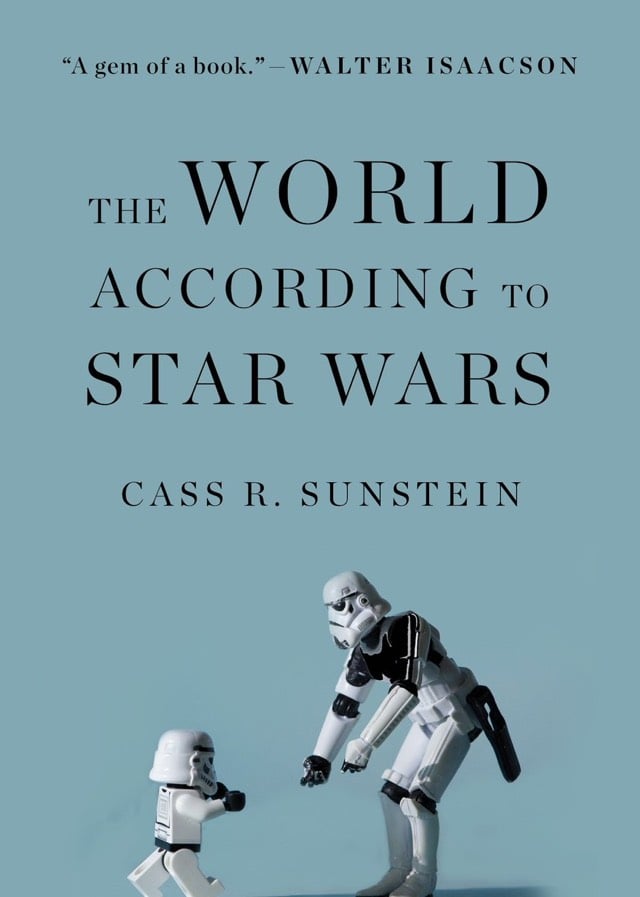
In The World According to Star Wars, Cass Sunstein explores the philosophy and life lessons of Star Wars.
In this fun, erudite and often moving book, Cass R. Sunstein explores the lessons of Star Wars as they relate to childhood, fathers, the Dark Side, rebellion, and redemption. As it turns out, Star Wars also has a lot to teach us about constitutional law, economics, and political uprisings.
Update: Sunstein, who is a professor at Harvard Law School, gave the commencement address last year at Penn Law. He starts off, dryly: “Graduates, faculty, family, friends, our topic today is Star Wars.”
(via @EmilyBrenn)



National Geographic has a selection of wonderful aerial photos from German photographer Bernhard Edmaier. His photos can also be found in two of his most recent books, Water and EarthArt.
In this Simpsons couch gag, the show pays homage to some classic Disney animation styles. Featured are Steamboat Willie, Cinderella, Snow White and the Seven Dwarfs, The Jungle Book and Fantasia. The animation was done by Eric Goldberg, who worked at Disney on films like Aladdin and Pocahontas.

This is the best thing I’ve read about Beyonce’s recently released album/film Lemonade.
*Beyoncé opens the door and Solange Knowles and Tina Lawson walk in.
Solange throws a reverse roundhouse kick that Jay Z lazily dodges.*
Solo: I’m sorry. I’m just very inspired right now.
Bey: Mommy! Solo! What a pleasant surprise! Neither of you could have had better timing
Jay: Sister-in-law. Mama Tina.
Mama T: Stereotypical Black Man
Solo: Blubberlips McSlutdick
Blue: LMAO
Bey: Baby, take your elevator to your playroom. Mommy will FaceTime you on your IPhone 8 when dinners ready.
Blue: Yes, mommy dearest
Solo: Rihanna called me to congratulate you.
Bey: She couldn’t call me?
Solo: Because you were gonna answer?
Bey: hahahahahahahahahaha
Solo: hahahahahahahahahaha
Mama T: lol omg
Bey: You may laugh
Jay: eh heh heh
Mama T: You are pathetic. The universe wasted good water creating you.
Bey: Mama. *high fives*
Someone took the audio from a BBC News report on North Korean military parade held in honor of Kim Jong-un’s birthday and played it over footage of the parade held in London in honor of Queen Elizabeth’s 89th birthday.
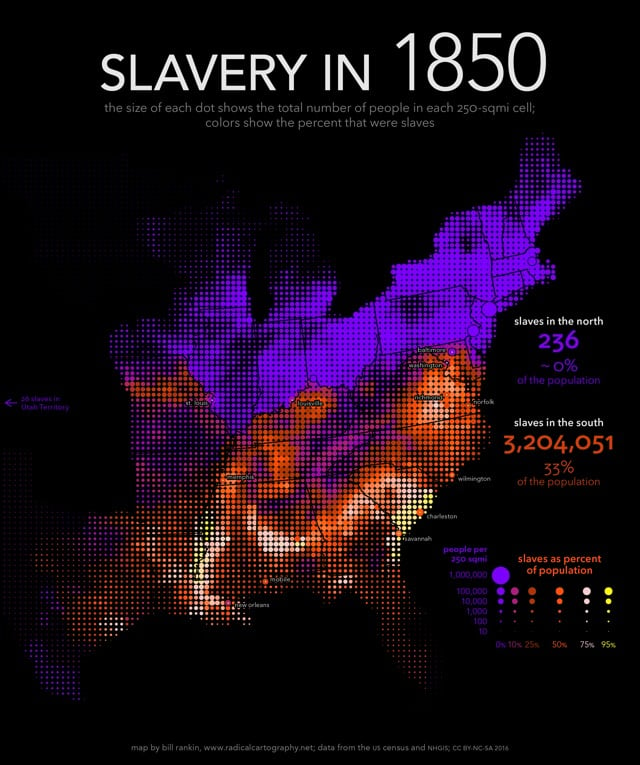
From Bill Rankin at Radical Cartography, a series of maps showing the rapid explosion of slavery in the United States from 1790-1860. Departing from previous efforts, Rankin used a uniform grid of dots to represent slave populations rather than counties.
First, I smash the visual tyranny of county boundaries by using a uniform grid of dots. The size of each dot shows the total population in each 250-sqmi cell, and the color shows the percent that were slaves. But just as important, I’ve also combined the usual county data with historical data for more than 150 cities and towns. Cities usually had fewer slaves, proportionally, than their surrounding counties, but this is invisible on standard maps.
A detail that struck me while cycling through the years was that the number of slaves as a percentage of the total population of the South stayed relatively steady at 33% from 1790 to 1860.
Blake Ross is 30 years old and he just learned something about everyone else in the world: people can visualize things in their minds. Which is like, yeah, duh. But Ross has aphantasia, which essentially means that his mind’s eye is blind, that counting sheep means nothing to him.
If you tell me to imagine a beach, I ruminate on the “concept” of a beach. I know there’s sand. I know there’s water. I know there’s a sun, maybe a lifeguard. I know facts about beaches. I know a beach when I see it, and I can do verbal gymnastics with the word itself.
But I cannot flash to beaches I’ve visited. I have no visual, audio, emotional or otherwise sensory experience. I have no capacity to create any kind of mental image of a beach, whether I close my eyes or open them, whether I’m reading the word in a book or concentrating on the idea for hours at a time — or whether I’m standing on the beach itself.
Understandably, this threw him for a bit of a loop.
—If I ask you to imagine a beach, how would you describe what happens in your mind?
—Uhh, I imagine a beach. What?
—Like, the idea of a beach. Right?
—Well, there are waves, sand. Umbrellas. It’s a relaxing picture. You okay?
—But it’s not actually a picture? There’s no visual component?
—Yes there is, in my mind. What the hell are you talking about?
—Is it in color?
—Yes…..
—How often do your thoughts have a visual element?
—A thousand times a day?
—Oh my God.
The more I read his story though, the more I started wondering if maybe I wasn’t a little aphantasic…or have become so as I get older. As far back as I can remember, I’ve been aware of the mind’s eye and visualization, but I just now tried to close my eyes and picture something but couldn’t. Ok, maybe that’s tough to do on demand. When was the last time I had pictured something? Not sure. Like Ross, I don’t dream or remember dreams (although I did when I was a kid), I’m bad with directions, my 6-year-old draws better than I do, I remember facts and ideas but not feelings so much, and when I was a designer, the conceptual stuff was always easier than the aesthetics. This bit also sounded familiar:
I’ve always felt an incomprehensible combination of stupid-smart. I missed a single question on the SATs, yet the easiest conceivable question stumps me: What was it like growing up in Miami?
I don’t know.
What were some of your favorite experiences at Facebook?
I don’t know.
What did you do today?
I don’t know. I don’t know what I did today.
Answering questions like this requires me to “do mental work,” the way you might if you’re struggling to recall what happened in the Battle of Trafalgar. If I haven’t prepared, I can’t begin to answer. But chitchat is the lubricant of everyday life. I learned early that you can’t excuse yourself from the party to focus on recalling what you did 2 hours ago.
I don’t know how much of that is the aphantasia and how much is positioning on the autistic spectrum or introversion or personality or some other kind of thing, but organizing events into narratives has never been easy for me.
What’s odd is I’ve always thought of my memory as a) pretty good, and b) primarily visual. When I took tests in college, I knew the answers because I could “see” them on the pages of the book I had read them in or in the notebook I had written them in. Not photographically exactly, but pretty close sometimes. I’m really good with faces, but not so much with names, although I’ve been improving lately with effort. I do well on visual tests, the ones where you need to pick out the same shapes that are rotated differently. Yes, I’m bad with directions, but once I’ve followed a route, I can usually muddle my way back along that same route visually. And sometimes, my feelings about past events are huge.
There’s this story I tell when the topic of celebrity sightings in New York comes up. My very first sighting happened a few months after I moved here. I was reading in a Starbucks in the West Village. Two women walk in, order, and sit in the back, maybe 25 feet away from me. At some point, I look up and I instantly recognize the woman who’s facing me: it’s Keri Russell. And in that moment, I understand celebrity. She was the most beautiful person I had ever seen in person in my life, and I’ve never even been a particular fan of hers, even though she is currently great in The Americans. It was her eyes, her crystal blue eyes. They were literally mesmerizing and I could not stop staring at them, which she noticed and I had to leave b/c I was being really weird.
So, two things about this story. Sitting here now, 13 years later, I can’t picture what she looked like, not exactly. There’s no image in my mind. She had short-ish hair and those blue eyes, but other than that, she looked…well, like Keri Russell. But when I recently told this story to a friend, he cocked his head and said, “she’s got blue eyes?” Oh yes, I told him, absolutely, those amazing lazer-blue eyes are the whole point of the story. A few days later, remembering his comment, I looked and Keri Russell’s eyes are not blue. They’re a greenish hazel!
Reader, I know memory is a weird thing and all, but what the hell is going on with me?
Full-screen this baby on the biggest high-definition screen you can find. A 5K iMac works spectacularly well.
If you’re going to watch the season 6 premiere of Game of Thrones tonight but you’ve forgotten what happened last season (tl;dr people died), watch this recap of last season’s action. I still can’t believe they made Marnie marry Desi after he missed their perfor oh wait that’s Girls.
You’re probably aware of Sinead O’Conner’s Nothing Compares 2 U but The Bangles, MC Hammer, Chaka Khan, Stevie Nicks, and others also made use of songs written by Prince.
Prince rides in on the back of a bearded man at around the 2:05 mark, yes you read that right. I had never seen this clip before and when he really gets going on stage, I started clapping and yelling in my apartment. Glorious. (via David Remnick at the New Yorker, who is almost annoyingly good at blogging)
The Founder is about the early years of McDonald’s and how Ray Kroc (played by Michael Keaton) came to gain control of the company. The official McDonald’s corporate history glosses over the events of the film in a few sentences:
In 1954, he visited a restaurant in San Bernardino, California that had purchased several Multi-mixers. There he found a small but successful restaurant run by brothers Dick and Mac McDonald, and was stunned by the effectiveness of their operation. They produced a limited menu, concentrating on just a few items-burgers, fries and beverages-which allowed them to focus on quality and quick service.
Kroc pitched his vision of creating McDonald’s restaurants all over the U.S. to the brothers. In 1955, he founded McDonald’s System, Inc., a predecessor of the McDonald’s Corporation, and six years later bought the exclusive rights to the McDonald’s name. By 1958, McDonald’s had sold its 100 millionth hamburger.
Kroc’s Wikipedia entry provides more flavor:
The agreement was a handshake with split agreement between the parties because Kroc insisted that he could not show the royalty to the investors he had lined up to capitalize his purchase. At the closing table, Kroc became annoyed that the brothers would not transfer to him the real estate and rights to the original unit. The brothers had told Kroc that they were giving the operation, property and all, to the founding employees. Kroc closed the transaction, then refused to acknowledge the royalty portion of the agreement because it wasn’t in writing. The McDonald brothers consistently told Kroc that he could make changes to things like the original blueprint (building codes were different in Illinois than in California), but despite Ray’s pleas, the brothers never sent any formal letters which legally allowed the changes in the chain. Kroc also opened a new McDonald’s restaurant near the McDonald’s (now renamed “The Big M” as they had neglected to retain rights to the name) to force it out of business.
See also some early McDonald’s menus.


Nasa Funahara makes art out of colorful masking tape, including recreations of famous artworks.
Pele: Birth of a Legend is a biopic about the rise of Pele, the Brazilian footballer. It was written and directed by Jeff and Michael Zimbalist, who also directed The Two Escobars, an excellent 30 for 30 film about Colombian drug lord Pablo Escobar and Colombian footballer Andres Escobar. (via @ivanski)

Angélica Dass’ Humanæ project matches photos of volunteer participants with the Pantone colors of their skin tones.
Update: Turns out this really cool blog you guys should be reading covered this project almost 4 years ago. (thx, @djacobs)
Idiocracy 10th anniversary screenings? Yes please.

From Neil Freeman, proprietor of the excellent Fake is the New Real, a map of the continental United States with the 50 states reorganized into concentric circles of equal population.
See also the map accompanying Parag Khanna’s recent piece, A New Map for America, which calls for the creation of seven mega-regions centered around metropolitan clusters in place of the lower 48 states: the Pacific Coast, the Inland West, the Great Plains, the Gulf Coast, the Great Lakes, the Southeast Manufacturing Belt, and the Great Northeast.
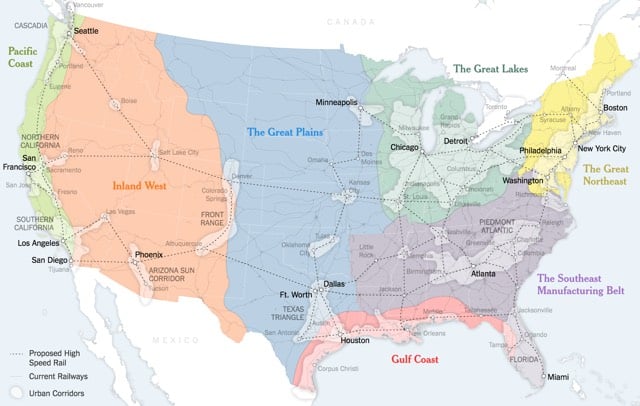
These days, in the thick of the American presidential primaries, it’s easy to see how the 50 states continue to drive the political system. But increasingly, that’s all they drive — socially and economically, America is reorganizing itself around regional infrastructure lines and metropolitan clusters that ignore state and even national borders. The problem is, the political system hasn’t caught up.
America faces a two-part problem. It’s no secret that the country has fallen behind on infrastructure spending. But it’s not just a matter of how much is spent on catching up, but how and where it is spent. Advanced economies in Western Europe and Asia are reorienting themselves around robust urban clusters of advanced industry. Unfortunately, American policy making remains wedded to an antiquated political structure of 50 distinct states.
To an extent, America is already headed toward a metropolis-first arrangement. The states aren’t about to go away, but economically and socially, the country is drifting toward looser metropolitan and regional formations, anchored by the great cities and urban archipelagos that already lead global economic circuits.
Holy shit, could you imagine? Most of America would have a fit over this.
In a video from the New Yorker, dancers from around the country demonstrate viral dance moves from the past decade, including the Dougie, Walk It Out, and Dabbing. (via @silviakillings)
Rex Sorgatz grew up in a small and isolated town (physically, culturally) in North Dakota named Napoleon.
Out on the prairie, pop culture existed only in the vaguest sense. Not only did I never hear the Talking Heads or Public Enemy or The Cure, I could never have heard of them. With a radio receiver only able to catch a couple FM stations, cranking out classic rock, AC/DC to Aerosmith, the music counterculture of the ’80s would have been a different universe to me. (The edgiest band I heard in high school was The Cars. “My Best Friend’s Girl” was my avant-garde.)
Is this portrait sufficiently remote? Perhaps one more stat: I didn’t meet a black person until I was 16, at a summer basketball camp. I didn’t meet a Jewish person until I was 18, in college.
This was the Deep Midwest in the 1980s. I was a pretty clueless kid.
He recently returned there and found that the physical isolation hasn’t changed, but thanks to the internet, the kids now have access to the full range of cultural activities and ideas from all over the world.
“Basically, this story is a controlled experiment,” I continue. “Napoleon is a place that has remained static for decades. The economics, demographics, politics, and geography are the same as when I lived here. In the past twenty-five years, only one thing has changed: technology.”
Rex is a friend and nearly every time we get together, we end up talking about our respective small town upbringings and how we both somehow managed to escape. My experience wasn’t quite as isolated as Rex’s — I lived on a farm until I was 9 but then moved to a small town of 2500 people; plus my dad flew all over the place and the Twin Cities were 90 minutes away by car — but was similar in many ways. The photo from his piece of the rusted-out orange car buried in the snow could have been taken in the backyard of the house I grew up in, where my dad still lives. Kids listened to country, top 40, or heavy metal music. I didn’t see Star Wars or Empire in a theater. No cable TV until I was 14 or 15. No AP classes until I was a senior. Aside from a few Hispanics and a family from India, everyone was white and Protestant. The FFA was huge in my school. I had no idea about rap music or modernism or design or philosophy or Andy Warhol or 70s film or atheism. I didn’t know what I didn’t know and had very little way of finding out.
I didn’t even know I should leave. But somehow I got out. I don’t know about Rex, but “escape” is how I think of it. I was lucky enough to excel at high school and got interest from schools from all over the place. My dad urged me to go to college…I was thinking about getting a job (probably farming or factory work) or joining the Navy with a friend. That’s how clueless I was…I knew so little about the world that I didn’t know who I was in relation to it. My adjacent possible just didn’t include college even though it was the best place for a kid like me.
In college in an Iowan city of 110,000, I slowly discovered what I’d been missing. Turns out, I was a city kid who just happened to grow up in a small town. I met other people from all over the country and, in time, from all over the world. My roommate sophomore year was black.1 I learned about techno music and programming and photography and art and classical music and LGBT and then the internet showed up and it was game over. I ate it all up and never got full. And like Rex:
Napoleon had no school newspaper, and minimal access to outside media, so I had no conception of “the publishing process.” Pitching an idea, assigning a story, editing and rewriting — all of that would have baffled me. I had only ever seen a couple of newspapers and a handful of magazines, and none offered a window into its production. (If asked, I would have been unsure if writers were even paid, which now seems prescient.) Without training or access, but a vague desire to participate, boredom would prove my only edge. While listlessly paging through the same few magazines over and over, I eventually discovered a semi-concealed backdoor for sneaking words onto the hallowed pages of print publications: user-generated content.
That’s the ghastly term we use (or avoid using) today for non-professional writing submitted by readers. What was once a letter to the editor has become a comment; editorials, now posts. The basic unit persists, but the quantity and facility have matured. Unlike that conspicuous “What’s on your mind?” input box atop Facebook, newspapers and magazines concealed interaction with readers, reluctant of the opinions of randos. But if you were diligent enough to find the mailing address, often sequestered deep in the back pages, you could submit letters of opinion and other ephemera.
I eventually found the desire to express myself. Using a copy of Aldus PhotoStyler I had gotten from who knows where, I designed party flyers for DJ friends’ parties. I published a one-sheet periodical for the residents of my dorm floor, to be read in the bathroom. I made meme-y posters2 which I hung around the physics department. I built a homepage that just lived on my hard drive because our school didn’t offer web hosting space and I couldn’t figure out how to get an account elsewhere.3 Well, you know how that last bit turned out, eventually.4
The fall of my senior year, he returned from a weekend at home in Chicago with a VHS tape in tow. He popped it into a friend’s VCR and said, “you’re about to see a future NBA star.” And we all watched some highlights of an 18-year-old Kevin Garnett he’d taped off the local news station.↩
One was a Beavis and Butthead sign warning people not to eat in the lab. Another was a “Jurassic Doc” poster featuring my thesis advisor who we all called “Doc”.↩
I eventually figured this out.↩
Robin Sloan is right: it’s tough to end things on the internet. Especially self-indulgent autobiographical rambling. Apologies. We now return to your regularly scheduled interestingness presented with minimal commentary.↩
Stelian Firez recently shared a really boneheaded web form for entering your phone number:

Soon afterward, several people attempted to conjure up even more cumbersome ways to ask people for phone numbers:




“Solutions” by Jeff Bonhag, Paulo Gaspar, Dan Kozikowski, and Justin. (via @ftrain)
Update: Thomas Park went old school with a rotary dial.

Worries over the slowing Chinese economy spilled out into the streets of Hebei province last weekend as two construction firms battled with bulldozers while competing for the same business. That is some end-times shit right there.
In his 1975 song Jungleland, Bruce Springsteen laments, “the poets down here don’t write nothing at all, they just stand back and let it all be.” I was reminded of that line when Springsteen canceled his North Carolina concert to protest the state’s recently passed bathroom law. In this case, the poet wrote. While it’s not unusual for musicians and other artists to use their public podiums for protest, it’s less common for corporations to do the same. At least, that used to be the case. But recently, many top CEOs are using their corporate muscle to influence social and political decisions across the country. When you wondered who would stand up for individual and equal rights in America, it’s unlikely that you thought of the The Boss and The Man. Here’s The New Yorker’s James Surowiecki with more on these unlikely alliances.

String Theory, a collection of David Foster Wallace’s writings on tennis will be out next month.1 The five pieces in the book include his NY Times’ essay on Federer and a 1991 piece from Harper’s. John Jeremiah Sullivan wrote an introduction, which was published recently in the New Yorker.
The collection is also available on the Kindle, without the Sullivan intro.
Hi, this is a footnote. Because Wallace. That’s it.↩
I love these trippy Simpsons brand ids created for FXX by LA-based Laundry.



Written, produced, and directed by Nate Parker, The Birth of a Nation is a film about Nat Turner, the man who led a slave rebellion in Virginia in 1831. The movie won both the Audience Award and Grand Jury Prize at Sundance this year and will be out in theaters in October.
P.S. If the name of the movie sounds familiar, it was deliberately given the same name as D.W. Griffith’s 1915 silent film, which dramatized the formation of the Ku Klux Klan. In an interview, Parker said:
When I endeavored to make this film, I did so with the specific intent of exploring America through the context of identity. So much of the racial injustices we endure today in America are symptomatic of a greater sickness - one we have been systematically conditioned to ignore. From sanitized truths about our forefathers to mis-education regarding this country’s dark days of slavery, we have refused to honestly confront the many afflictions of our past. This disease of denial has served as a massive stumbling block on our way to healing from those wounds. Addressing Griffith’s Birth of a Nation is one of the many steps necessary in treating this disease. Griffith’s film relied heavily on racist propaganda to evoke fear and desperation as a tool to solidify white supremacy as the lifeblood of American sustenance. Not only did this film motivate the massive resurgence of the terror group the Ku Klux Klan and the carnage exacted against people of African descent, it served as the foundation of the film industry we know today.
I’ve reclaimed this title and re-purposed it as a tool to challenge racism and white supremacy in America, to inspire a riotous disposition toward any and all injustice in this country (and abroad) and to promote the kind of honest confrontation that will galvanize our society toward healing and sustained systemic change.
(via trailer town)
Amazon is now offering the ability to subscribe to Prime and Prime Video monthly rather than just yearly. Prime Video is $8.99/mo (Netflix is going up to $9.99/mo soon) and the full Prime offering is $10.99/mo. A year of Prime is still $99.
In Prime Video, Amazon has built a worthy competitor to Netflix. And it actually might be better at this point. The stable of impressive Netflix originals aside (which Amazon is also doing *cough* Transparent *cough* best show in years), Amazon allows you to rent/buy digital movies not available for free streaming1, provides discounts for subscriptions to Showtime and Starz, and (if you opt for the full Prime) offers free shipping on most stuff in the store (as well as other benefits.) I sub to both services, but if I had to make a choice right now, I’d probably stick with Amazon.
What Amazon should do, to really sweeten the deal (if the movie studios would allow such a thing), is offer Prime-only discounts on renting and buying digital movies and shows. So not only would you get a bunch of free streaming movies, you can rent new-to-video movies, and they’re cheaper than at iTunes. That’s something that Netflix can’t offer right now. I wonder if they’ll add a digital video store to their offering to compete?↩
When the Titanic struck an iceberg in the North Atlantic on April 14, 1912, it took the ship 2 hours and 40 minutes to sink. I don’t necessarily know why you would want to, but now you can watch a highly detailed animation of the ship sinking in realtime, all 2h 40m. I can’t quite figure out if this is appropriate or not, although when I think about the inevitable realtime 9/11 version, perhaps it isn’t.
NES player darbian just broke his own record for the fastest time through Super Mario Bros. He completed the entire game in just 4 minutes 57.260 seconds. But the most entertaining part of the video is watching his heart rate slowly creep up from 80 bpm at the beginning to ~140 bpm in World 8-2 and spiking to 171 bpm when he beats the record. (via digg)
Update: Compare that with this insane level from Mario Maker:
(via @pieratt)

In this post about Minecraft yesterday, I wrote a footnote about educational-ish1 apps on my iPad:
On my iPad, I have a screen full of educational apps that the kids can work with pretty much anytime they want without asking.
I posted a screenshot of that page on Twitter, and I wanted to follow up with some App Store links as well as some links to other apps that people tweeted back at me. (Note: my kids are 6 and 8, so YMMV.)
Minecraft Pocket Edition - Duh. It doesn’t do quite as much as the full versions available on other platforms, but they’re improving and adding stuff all the time and the touchscreen experience is great.
The Tinybop Collection - Beautiful, fun apps. The kids most often work with The Everything Machine and Simple Machines.
Mate in 1 - A game that challenges you to find the checkmate using just one move. Ollie takes chess after school once a week, so I downloaded this for when he wants some extra practice during the week. See also Mate in 2.
Monument Valley - This is a straight-up game, but it’s so well-made (I love the soundtrack) and the logic puzzles are genuinely challenging that I’m happy to let them work with this one. Ollie has made it all the way through while Minna is still on level 9. Gonna get the Forgotten Shores IAP too.
The Numberlys - This one has ceased to be educational for my kids, but it’s great for the younger set.
Crazy Gears - 99 levels of mechanical puzzles involving gears.
Hopscotch - Use an intuitive drag-and-drop interface to build games. It includes many video tutorials for learning how everything works.
And here are a few recommendations from others that I am eager to try out:
Quick Math Pack - Four math apps, including multiplication, fractions, and telling time. See also Prodigy Math Game, The Counting Kingdom, the DragonBox apps.
Barefoot World Atlas - An annotated world atlas. This looks great…downloading now.
Epic! - A eBook library for kids 12 and under with 10,000 titles. A couple of very strong recommendations from people for this.
Brain It On - Draw shapes to solve challenging physics puzzles. See also LiquidSketch.
Endless Reader - For beginning readers. The same company, Originator Inc., has many other apps as well.
Professor Astro Cat’s Solar System - Learn about the solar system with a cat and mouse as tour guides.
Deep Green - Top-notch chess game.
Lots of good stuff there…I’ve downloaded a few already. I really really wish the App Store had a try-before-you buy policy. I have no idea which of these apps the kids will actually like/play and it would be nice not to have to spend $50 to find out. Anyway, thanks to everyone who shared their favorites. Let me know if I’ve missed anything great!
As you might have guessed from reading this here web site, I tend to have an expansive definition of what is educational. Hence, “educational-ish” to adjust people’s expectations.↩
From The Intercept and director A.J. Schnack, a simple and powerful short film about more than a dozen mass shootings that have occurred in the US since 2011.
A scene of tragedy unfolds, accompanied by fear, chaos and disbelief. As Speaking is Difficult rewinds into the past, retracing our memories, it tells a story about a cumulative history that is both unbearable and inevitable.
Fuck, that was difficult to watch. When Sandy Hook came up, I just lost it. We should be deeply deeply ashamed that that happened and we did nothing about it.
NYC water tastes amazing. Better than bottled. Where does the city get such great water from?
The Catskill/Delaware watershed, which extends 125 miles northwest of the city, provides more than 90 percent of the city’s supply. The rest comes from the Croton watershed.

It can take 12 weeks to a year for water to wind its way to the city from the streams, tunnels, dams and reservoirs in the Catskills. All of it is delivered to the city by gravity alone.
“Gravity’s an important friend of ours,” said Mr. Rush, the deputy commissioner, explaining that it “works nonstop” and is “energy efficient.”
Whoa, I had no idea the aqueduct tunneled 1000 feet under the Hudson River. Water systems have been in the news lately, both in Flint, MI and here in NYC, where Mayor de Blasio postponed work on Water Tunnel #3 and then, a day later, responding to public concern over the postponement, announced that he was going to accelerate the work on Tunnel #3.
See also David Grann’s classic 2003 New Yorker piece about the NYC water system, City of Water.
The author accompanied a group of sandhogs and nine cases of dynamite six hundred feet down a shaft leading to a segment of the tunnel that lies below Tenth Ave. and 13th St. New York’s invisible underground empire goes as deep as the Chrysler building is high. Tunnel No. 3 has been under construction since 1969; it will extend sixty miles, from the reservoir in Yonkers to the end of Manhattan, with various redundant loops.
Kurzgesagt examines what’s happened to our privacy, civil liberties, and security because of the threat of terrorism.
For the Love of Spock is a documentary about Leonard Nimoy and the beloved character he played on Star Trek. Nimoy’s son Adam is the director, the film was funded with the help of Kickstarter, and is playing at the Tribeca Film Festival this weekend (with special guest appearance by Zachary Quinto).
Body cameras, dashboard cams, and bystander videos all offer different views of police officers doing their jobs, which underscores the importance of perspective in skewing our perceptions of what’s happening. For instance, body cams can tend to put you in the shoes of the wearer.
These details were not captured by the police body camera, though, revealing another important point: Body cameras prioritize the officer’s point of view.
“When video allows us to look through someone’s eyes, we tend to adopt an interpretation that favors that person,” Professor Stoughton said, explaining a psychological phenomenon known as “camera perspective bias.”
Thanks to Reed for sending me the link and pointing out the connection to how film directors use the camera to tell stories effectively:
The importance of composition in cinematic storytelling and “What a film director really directs is the audience’s attention.” What are these law enforcement surveillance cameras inadvertently directing our attention to?

Clive Thompson’s article for the NY Times about Minecraft captures what many players, parents, and teachers find exciting about the game that seems like more than just a game.
Presto: Jordan had used the cow’s weird behavior to create, in effect, a random-number generator inside Minecraft. It was an ingenious bit of problem-solving, something most computer engineers I know would regard as a great hack — a way of coaxing a computer system to do something new and clever.
In addition to learning about logic and computer science, various educators have also touted Minecraft’s lessons in civics, design, planning, and even philosophy. If you’ve ever seen little kids playing with blocks, you’ve noticed that some of those potential lessons there too.
Block-play was, in the European tradition, regarded as a particularly “wholesome” activity; it’s not hard to draw a line from that to many parents’ belief that Minecraft is the “good” computer game in a world full of anxiety about too much “screen time.”
Among the parents I know, Minecraft is not classified as a game…it’s very much tied to education.1 And when listening to the kids and their friends talk about it, if you can get past the endless chatter about zombies and diamond armor, their understanding of the whole world of possibilities is quite sophisticated.
And I can’t resist commenting on this little aside about Lego:
Today many cultural observers argue that Lego has moved away from that open-ended engagement, because it’s so often sold in branded kits: the Hogwarts castle from “Harry Potter,” the TIE fighter from “Star Wars.”
Until very recently, I was in that camp of cultural observers, frustrated by the brands and paint-by-number aspect of contemporary Lego kits. But my kids play with Lego a ton and I’ve observed plenty of open-ended engagement going on. Sure, they sit for 20-30 minutes putting the kits together using directions, but after they’re “done”, the real play begins. Ollie’s Star Wars ships dock at Minna’s birthday party. Soon, beach goers are wearing Stormtrooper helmets and Vader’s eating cupcakes. None of the “finished” products survive more than a few minutes without being augmented or taken apart to make something different. Ships take on wheels from previous kits and become delivery trucks (with cool laser cannons). Parts from every station, house, vehicle, and landscape get remixed into whatever’s necessary for their dramatic play. It’s like jazz with injection molded plastic.
On my iPad, I have a screen full of educational apps that the kids can work with pretty much anytime they want without asking. (To play Alto’s Adventure or Subway Surfer, they have to ask.) Minecraft is not on this screen — and I had to explain my decision on this specifically to the kids — but this article may have persuaded me to add it.↩
This animation is super-freaky and somewhat NSFW and you should just watch it. Also: and that’s why you always leave a note. (via @gavinpurcell)
From Fusion, a 45-minute documentary about the making of Zootopia.
Fusion spent two years with the production team of Disney’s smash hit film. In ‘Imagining Zootopia,’ you will travel with the team to Africa to explore the animals in their natural habitat and find out how the storytellers and animators dealt with the very real themes of prejudice and bias.
I found this via Khoi Vinh, who writes:
A lot of careful thought went into how to render the emotional truth behind experiencing racism, and the documentary takes a detailed look at the filmmakers grappling with that. However, it also betrays one of the unfortunate truths of the production; the movie is commendably bold about addressing prejudice, but it’s evident from watching the documentary that of the five-hundred plus people who contributed to the film, hardly any were non-white, and even fewer were African-American.
For a criticism of Zootopia’s racial allegory, read Devin Faraci’s A Muddled Mess of Racial Messaging… And Cute Animals.
Alexey Zakharov gathered old photos of New York, Washington D.C. and other American cities from Shorpy and animated them into something wonderful. There’s a cheesy steampunk time machine at the beginning…push through that to the good stuff. (via @pshoplifter)
Just learned/realized that the old logos for Reebok, Apple, and Trapper Keeper all use the same typeface, Motter Tektura.
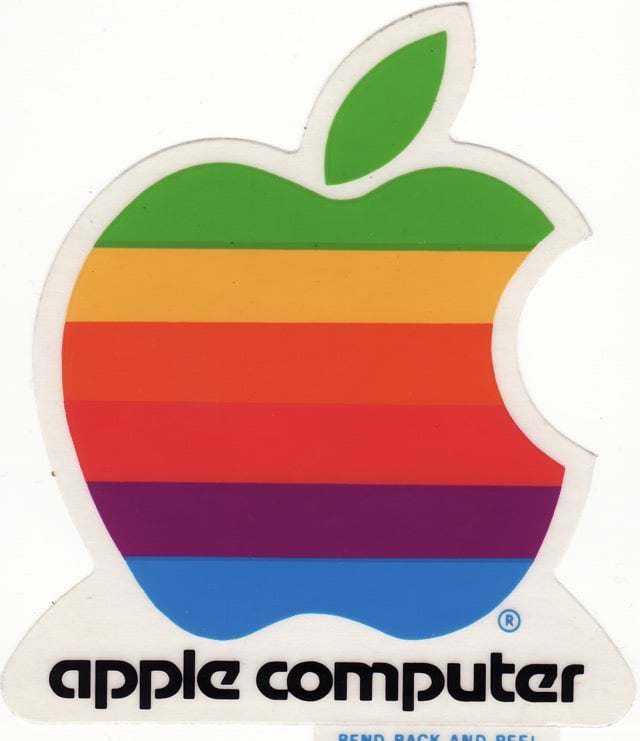


(via @pieratt)
In a new video, Even Puschak talks about the rise of the serialization genre, from Dickens to Flash Gordon to General Hospital to Star Wars. Now that our entertainment is increasingly serialized, he argues that audiences have a unique opportunity to shape what we watch. (Case in point: the increased importance of non-white and non-male characters in The Force Awakens and Rogue One.)
Further reading: Wired’s You Won’t Live to See the Final Star Wars Movie, which I’ve thought about almost every week since I read it.
Everywhere, studio suits are recruiting creatives who can weave characters and story lines into decades-spanning tapestries of prequels, side-quels, TV shows, games, toys, and so on. Brand awareness goes through the roof; audiences get a steady, soothing mainline drip of familiar characters.
Forget the business implications for a moment, though. The shared universe represents something rare in Hollywood: a new idea. It evolved from the narrative techniques not of auteur or blockbuster films but of comic books and TV, and porting that model over isn’t easy. It needs different kinds of writers and directors and a different way of looking at the structure of storytelling itself. Marvel prototyped the process; Lucasfilm is trying to industrialize it.
And Puschak recommends Consuming Pleasures by Jennifer Hayward.
Ranging from installment novels, mysteries, and detective fiction of the 1800s to the television and movie series, comics, and advertisements of the twentieth century, serials are loosely linked by what may be called “family resemblances.” These traits include intertwined subplots, diverse casts of characters, dramatic plot reversals, suspense, an such narrative devices as long-lost family members and evil twins. Hayward chooses four texts to represent the evolution of serial fiction as a genre and to analyze the peculiar draw that serials have upon their audiences: Dickens’s novel Our Mutual Friend, Milton Canif’s comic strip Terry and the Pirates, and the soap operas All My Children and One Life to Live. Hayward argues that serial audiences have developed active strategies of consumption, such as collaborative reading and attempts to shape the production process. In this way fans have forced serial producers to acknowledge the power of the audience.
All this makes me realize that I’ve often thought of kottke.org as a serial. The “family resemblances” amongst all my posts might be difficult to see sometimes, but it’s there most of the time. In my mind, at least.
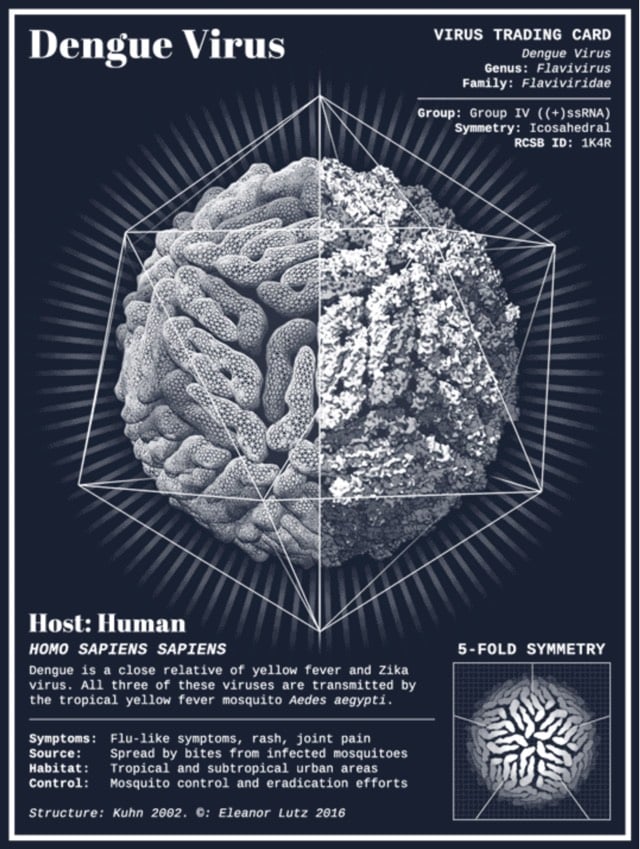
Eleanor Lutz’s latest infographic creation is a set of animated virus trading cards.
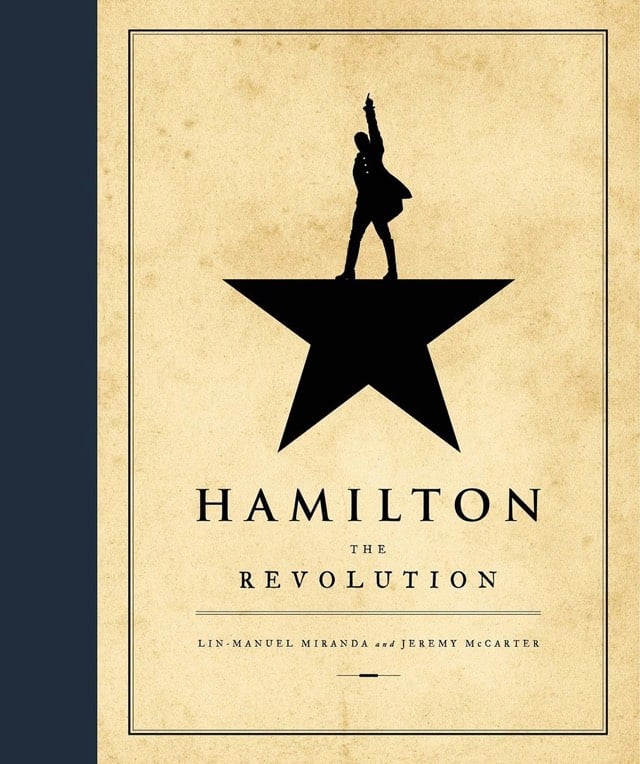
The Broadway musical Hamilton is having a bit of a moment right now. Ok, not really. Lin-Manuel Miranda’s smash hit has seemingly had one loooong moment since he performed “Alexander Hamilton” in front of the President and Mrs. Obama at the White House in 2009.
The show is sold out1 until who knows when, the original cast album went gold and won a Grammy, and they’re doing spin-off productions in Chicago, LA, and SF — all this scarcely more than a year since Rebecca Mead wrote up Miranda and Hamilton in the New Yorker.2 Bernie Sanders took in the show last week. And this week, a book about the production of the play came out.
Hamilton: The Revolution gives readers an unprecedented view of both revolutions, from the only two writers able to provide it. Miranda, along with Jeremy McCarter, a cultural critic and theater artist who was involved in the project from its earliest stages — “since before this was even a show,” according to Miranda — traces its development from an improbable performance at the White House to its landmark opening night on Broadway six years later. In addition, Miranda has written more than 200 funny, revealing footnotes for his award-winning libretto, the full text of which is published here.
Add to that a flurry of articles (several from the NY Times, which has a dedicated staff of 162 reporters on the beat) that came out in the past week or so: Why Hamilton Matters, Lin-Manuel Miranda: By the Book (he’s never finished Infinite Jest), ‘Hamilton’ and History: Are They in Sync?, A Hamilton Skeptic on Why the Show Isn’t As Revolutionary As It Seems, and The C.E.O. of ‘Hamilton’ Inc. How much bigger can this thing get?
Update: And now Miranda has won a Pulitzer.
Hey, if anyone’s got a ticket and wants to take me, I’m free literally any time/day/year. Hahahaha. No seriously, email me. Hahaha. (No, really. AFTER ALL I’VE DONE FOR YOU UNGRATEFUL MOTH ↩
You know who else Mead wrote up in the New Yorker many years ago?! Hint: it’s not actually Hitler this time…↩
Amazon debuts new Kindle Oasis. Super light, thin, long-lasting battery, dedicated page-turn buttons, etc.
Greenland sees record-smashing early ice sheet melt. That graph is terrifying.
If you’re poor, you might want to consider moving to a place where your life expectancy will be reasonably high. In many parts of America, there is only a minor gap between the life expectancies of the wealthy and the poor.
But in some other parts of the country, adults with the lowest incomes die on average as young as people in much poorer nations like Rwanda, and their life spans are getting shorter.
If you’re rich, you’re probably OK right where you are (regardless of where that happens to be). Here are some remarkable numbers from the NYT Upshot: The rich live longer everywhere. For the poor, geography matters.
Russian billionaire Yuri Milner, with the help of Stephen Hawking and Mark Zuckerburg, plans to launch a fleet of nano-probes1 toward a star close to our solar system, Alpha Centuri. The craft, outfitted with lightsails, will be pushed along to their destination in just 20 years by powerful lasers on Earth.
In the last decade and a half, rapid technological advances have opened up the possibility of light-powered space travel at a significant fraction of light speed. This involves a ground-based light beamer pushing ultra-light nanocrafts - miniature space probes attached to lightsails - to speeds of up to 100 million miles an hour. Such a system would allow a flyby mission to reach Alpha Centauri in just over 20 years from launch, and beam home images of possible planets, as well as other scientific data such as analysis of magnetic fields.
Breakthrough Starshot aims to demonstrate proof of concept for ultra-fast light-driven nanocrafts, and lay the foundations for a first launch to Alpha Centauri within the next generation. Along the way, the project could generate important supplementary benefits to astronomy, including solar system exploration and detection of Earth-crossing asteroids.
The Atlantic and the NY Times have more information on the initiative.
Sure, we can launch laser-powered nano-probes toward a distant star, but humanity still struggles with proper descriptive URLs.↩
As the US and Cuba move toward becoming BFFs again (or at least members of the same #squad), it’s a good time to review the history between the two countries, which includes slavery, the Spanish-American War, and the Cold War-era series of fiascos.
The San Francisco earthquake of 1906 and the resulting fires destroyed 500 blocks, 25,000 buildings, killed more than 3000 people, and left more than half the city homeless. Alan Taylor curated a selection of photos of the earthquake and aftermath. The most striking ones are those taken from an airship that show how complete and extensive the destruction was. I mean:

Sam Hinkie recently resigned as general manager of the NBA’s Philadelphia 76ers. His resignation letter took the form of an investor letter, a la Warren Buffett’s annual letters. Before he gets down to basketball specifics, Hinkie spends several pages explaining his philosophy. Along with Buffett and his business partner Charlie Munger, Hinkie mentions in this introductory section Atul Gawande, Elon Musk, Bill James, James Clerk Maxwell, Bill Belichick, Jeff Bezos, Tim Urban (whom he suggests the Sixers owners should meet for coffee), AlphaGo, and Slack (the Sixers’ front office uses it). He even quotes Steven Johnson about the adjacent possible:
A yearning for innovation requires real exploration. It requires a persistent search to try (and fail) to move your understanding forward with a new tool, a new technique, a new insight. Sadly, the first innovation often isn’t even all that helpful, but may well provide a path to ones that are. This is an idea that Steven Johnson of Where Good Ideas Come From popularized called the “adjacent possible.” Where finding your way through a labyrinth of ignorance requires you to first open a door into a room of understanding, one that by its very existence has new doors to new rooms with deeper insights lurking behind them.
If I didn’t know any better, I’d guess that Hinkie is a regular kottke.org reader. (via farnum street)

It did not work for Gilligan and the Skipper, but writing “HELP” with palm fronds on the beach got three men rescued from a deserted island in the Pacific.
A Navy P-8 Madfox 807 aircrew from Misawa Air Base in Japan was conducting a search pattern for the missing mariners when they spotted survivors holding lifejackets and their makeshift sign. This information was relayed back to search and rescue watchstanders in Guam and shared with the family. The survivors were then picked up and transferred by a local small boat to Pulap.
Update: A woman in Arizona was rescued a few days ago in part because of a HELP sign she wrote with sticks.

(via @mchamblin)
Can you love your daily commute? “Let reality be reality.”
If they survive at all, recordings of a lot of older music (pre-50s or -60s) don’t sound great because they were taken from old records that aren’t in the best shape. This 1929 recording of Louis Armstrong & His Orchestra playing Ain’t Misbehavin’ was taken from what’s called a “mother record”, a metal disc that’s produced from the master disc. As you can hear, recording directly from a mother gives you an incredibly crisp and clear result:
Wow. It sounds so much better than the same song recorded in a more conventional way:
We’re so conditioned to hearing 90-year-old music with that muddy record hiss that the mother recording is a revelation, like seeing early color photography and film.
A poison ivy quiz. Tis the season.
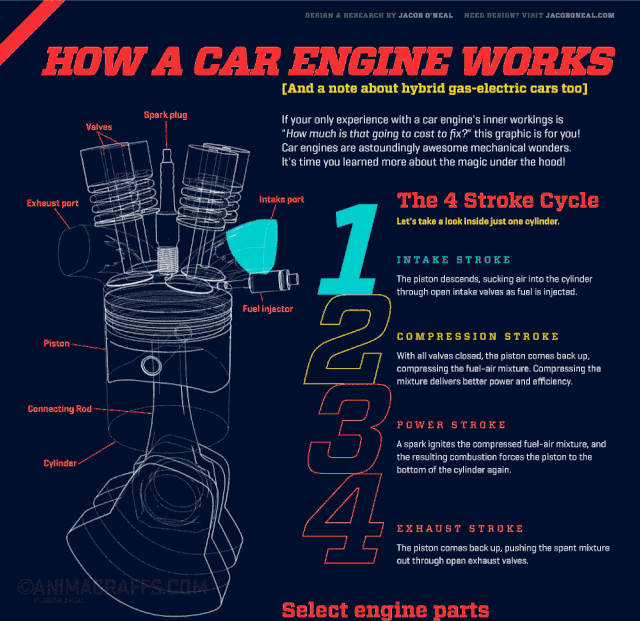
From Jacob O’Neal, a great series of animated GIFs about how internal combustion engines work. There are separate animations of the fuel, air, cooling, oil, electrical, and exhaust systems.
See also O’Neal’s animations on how a jet engine works and how a handgun works.
This video from Vox makes an often overlooked point about climate change. Climate change is not about saving the planet. Earth will be fine. Life, in general, will be fine. But many species of plants and animals will die. Addressing climate change is about saving plants and animals that are in some way “useful” to us and preventing human suffering. (via @mims)
Update: George Carlin riffs on this point in an old standup routine:
There is nothing wrong with the planet. The planet is fine. The people are fucked.
(via @austinkleon)
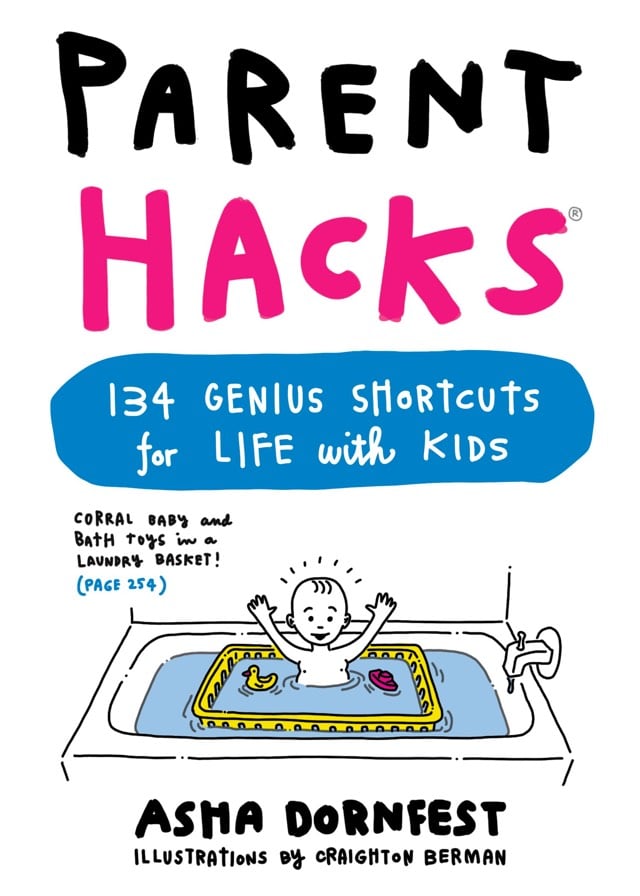
Asha Dornfest runs the Parent Hacks blog and she’s collected some of her best tips into a new book, Parent Hacks: 134 Genius Shortcuts for Life with Kids.
A parent hack can be as simple as putting the ketchup under the hot dog, minimizing the mess. Or strapping baby into a forward-facing carrier when you need to trim his fingernails-it frees your hands while controlling the squirming. Or stashing a wallet in a disposable diaper at the beach-who would ever poke through what looks like a used Pamper?
Dave Pell from Nextdraft tipped me off to the book, writing:
My friend Asha Dornfest has turned her excellent parenting blog into an even more excellent parenting book with 134 ingenious ideas for simplifying life with kids. Parent Hacks is so good that I may even have a few more kids.
The latest video from Kurzgesagt is on space elevators. How would you build one? Why not just keep launching rockets into space instead? Would be easier to build one on the Moon first?
A few days ago, I watched An Honest Liar, a documentary about the magician and charlatan-debunker The Amazing Randi. I had forgotten that in the 70s and 80s in America, belief in psychics like Uri Geller, faith healers like Peter Popoff, extraterrestrial abductions, and the like was not all that far from the mainstream. Such events and people were covered in newspapers, on the evening news, and featured on talk shows, including The Tonight Show with Johnny Carson.
The media is awash in pieces attempting to explain the success of the Presidential campaign of Donald Trump. Many are puzzled…how could this happen in America!? After watching Randi debunking hoaxes, I’m no longer surprised at Trump’s success. Maria Konnikova, author of a recent book on scams and cons, wrote about Trump and con artists for the New Yorker.
A line, thin but perceptible, divides even egregious liars from confidence men. People deceive one another for all sorts of reasons: they might lie to stay out of trouble, for example, or to make themselves seem more interesting, or to urge a business deal toward its consummation. David Maurer, a linguist turned historian of the con, said, “If confidence men operate outside the law, it must be remembered that they are not much further outside than many of our pillars of society who go under names less sinister.” Still, there is a meaningful difference between an ordinary liar and a con artist. A grifter takes advantage of a person’s confidence for his own specific ends — ends that are often unknowable to the victim and unrelated to the business at hand. He willfully deceives a mark into handing over his trust under false pretenses. He has a plan. What ultimately sets con artists apart is their intent. To figure out if someone is a con artist, one needs to ask two questions. First, is their deception knowing, malicious, and directed, ultimately, toward their own personal gain? Second, is the con a means to an end unrelated to the substance of the scheme itself?
She doesn’t express an opinion on whether Trump is a con artist — it’s difficult to tell without knowing his intent — but it’s clear that like Uri Geller and Peter Popoff, Trump is adept at making people believe what he is saying without a lot of hard evidence. Like The Amazing Randi said in the movie: “no matter how smart or well educated you are, you can be deceived.” Hopefully, like Geller, Popoff, and UFOs eventually did, the idea of Trump as a viable candidate for President will soon disappear back into the fringes of American discourse.
Koyannistocksi is a shot-by-shot remake of the trailer for Godfrey Reggio’s Koyaanisqatsi using only stock footage.
A testament to Reggio’s influence on contemporary motion photography, and the appropriation of his aesthetic by others for commercial means.
(via @waxpancake)
Camilo Jose Vergara’s Tracking Time project is a collection of photos of locations around the US (LA, Harlem, Detroit, South Bronx) photographed repeatedly over the years, from the 70s to the present day. For instance, here’s how 65 East 125th St in Harlem looked in 1978:
![]()
In 1998:
![]()
And in 2015:
![]()
As Stewart Brand noted, Vergara’s project is a perfect illustration of How Buildings Learn.
Update: I can’t stop looking at these. Check out Fern St. in Camden, New at Newark Sts. in Newark, Paired Houses in Camden, and 6003 Compton Ave. in LA.

When six of Phil Collins’ albums were recently remastered, he went back and recreated the covers as well. That’s fun! (via @pieratt)
Update: Patrick Balls was the photographer for the reshoots.
When P.T. Anderson submitted the first draft of his script for Boogie Nights, the studio didn’t think too much of it.
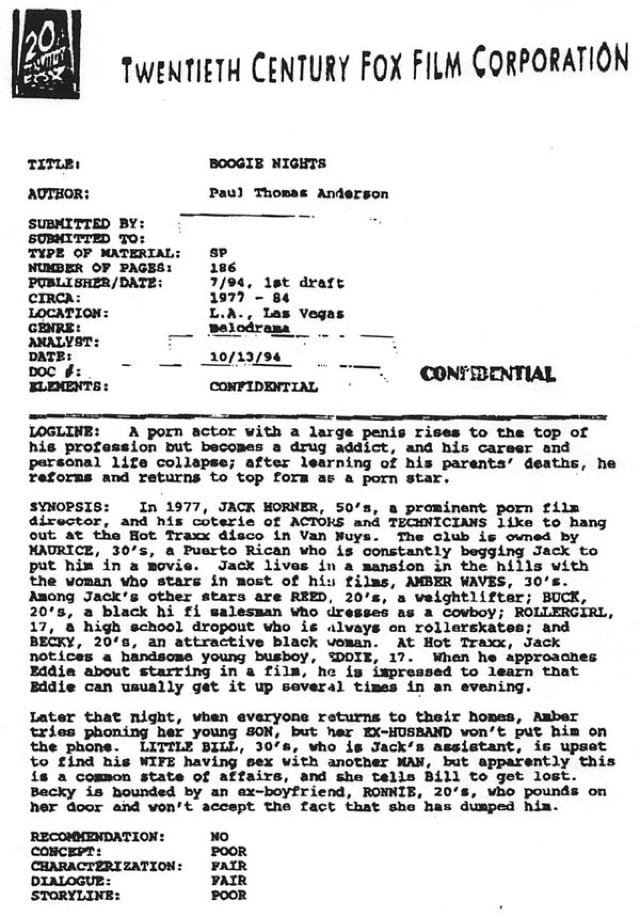
Boogie Nights is one of my favorite films. I’m glad Anderson stuck with it.
Hamilton and the (obvious?) pitfalls of learning history from literary or theatrical productions
If you can stop gawping at Alaska’s gorgeous scenery long enough, you can witness drone footage of a whole lot of salmon migrating upstream from Lake Iliamna1 to spawn. (via digg)
Lake Iliamna is home to the supposed Iliamna Lake Monster, a beast “10-30 feet in length with a square-like head that is used to place blunt force unto things such as small boats”. Where’s the drone footage of that?!↩
The Disaster of Richard Nixon. Worst President ever?
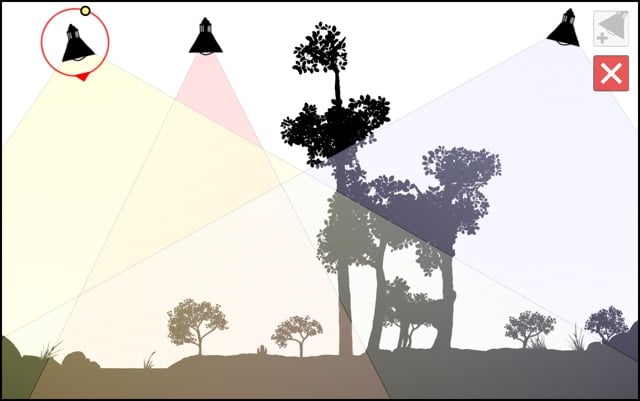
For April Fools’ Day, Randall Munroe made an interactive widget where you can grow your own garden. Here’s mine so far. Others’ gardens are further along, with people and octopuses showing up. As with real gardens, the keyword is “patience”.
Update: In experimenting with his garden, @dennis_e_a found:
One color of light on a spot of ground changes what grows. Red: Desert, Blue: Ocean, Yellow: Park-ish
I have modified my lighting accordingly, but my flora and fauna have yet to follow suit. Perhaps I need to prune a bit?
The trailer for the first “Star Wars Story” has dropped.1 Rogue One is about how the Rebellion stole the plans for the Death Star before the events of A New Hope. Don’t read the comments on YouTube…there’s whining about how the protagonist is a woman and the cast is diverse. :(
“A Star Wars Story”…that’s a bit of a hamfisted name. Regardless, there are two other “Story” films planned so far that focus on Han Solo (pre-Hope) and Boba Fett (pre-Empire).↩
They go hard on the rhymes with A New Hope angle. I LOL’d when they called JJ Abrams “diet Spielberg”.
The Popquotery Instagram account mixes fine art with pop culture quotations, mostly from movies. Here for instance, is Degas + Ferris Bueller:
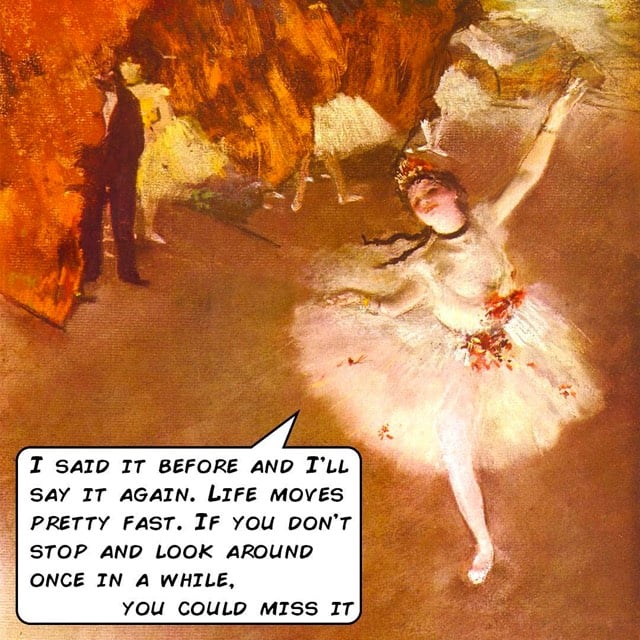
And Waterhouse + Back to the Future:
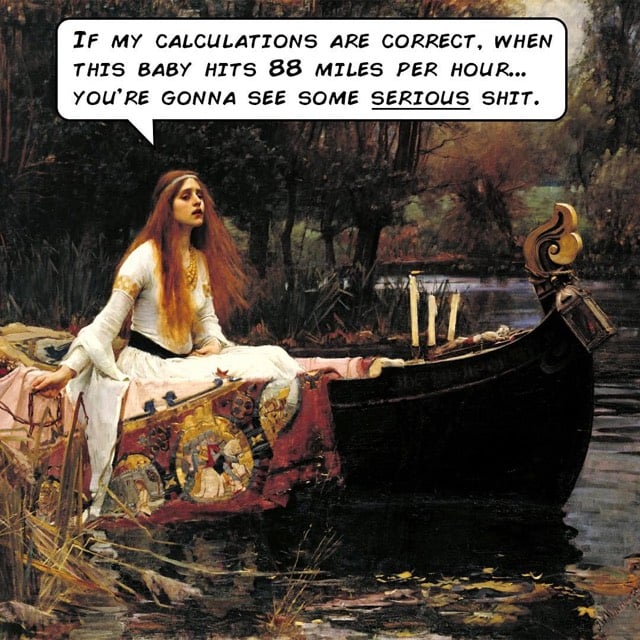
How about Gowy + Top Gun:
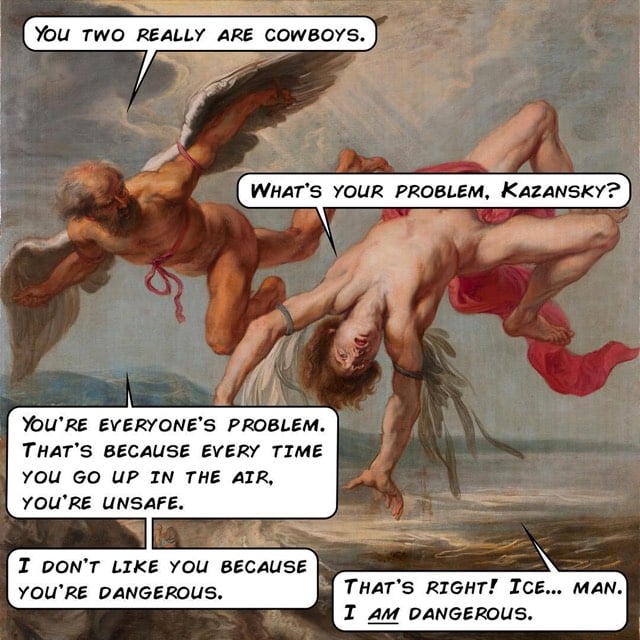
In this short film, Manhattan becomes Mannahatta again, as the plants take over when the humans leave the city. The early part of the film, before the twist, has a This Is Legend vibe, but it also reminds me of a book I read with my kids, The Curious Garden, about a High Line-like elevated park that spreads across an industrial city. (via colossal)
Actor and singer François Clemmons, who played Officer Clemmons for 30 years on Mister Rogers’ Neighborhood, talks about how and why Fred Rogers chose a black man to be a police officer on TV.
To say that he didn’t know what he was doing, or that he accidentally stumbled into integration or talking about racism or sexism, that’s not Mister Rogers. It was well planned and well thought-out and I think it was very impactful.
NPR also recently shared Clemmons’ story.
He says he’ll never forget the day Rogers wrapped up the program, as he always did, by hanging up his sweater and saying, “You make every day a special day just by being you, and I like you just the way you are.” This time in particular, Rogers had been looking right at Clemmons, and after they wrapped, he walked over.
Clemmons asked him, “Fred, were you talking to me?”
“Yes, I have been talking to you for years,” Rogers said, as Clemmons recalls. “But you heard me today.”
“It was like telling me I’m OK as a human being,” Clemmons says. “That was one of the most meaningful experiences I’d ever had.”
Mister Rogers always hits me right in the feels.
Star Wars: The Force Awakens is now out on Blu-ray and digital download. If you have Sphero’s BB-8 toy, you can have BB-8 watch the movie with you and react to what’s going on on-screen. Here’s BB-8 reacting to seeing the Millennium Falcon for the first time in the movie:

Scott Lininger and Mike Magee built a fully playable WebGL version of the original Legend of Zelda, which came out 30 years ago. Works in any modern web browser. Not sure how long this is going to be up, but it’ll be fun while it lasts.
A group of organizations, including Microsoft and the Rembrandthuis museum, have collaborated to produce a new painting by Rembrandt. Or rather, “by” Rembrandt. The team wrote software that analyzed the Dutch master’s entire catalog of paintings and used the data to create a 3D-printed Rembrandt-esque painting.
We now had a digital file true to Rembrandt’s style in content, shapes, and lighting. But paintings aren’t just 2D — they have a remarkable three-dimensionality that comes from brushstrokes and layers of paint. To recreate this texture, we had to study 3D scans of Rembrandt’s paintings and analyze the intricate layers on top of the canvas.
I’d say they did pretty well:

I wonder though, to what extent is this an averaged Rembrandt? According to the program, is there one canonical Rembrandt-esque eye and that’s it? Or can the program paint dozens of variations? After all, because he was (presumably) working with actual people, Rembrandt himself had hundreds or thousands of ways to paint, it wasn’t just the same sort of mouth over and over.
See also Loving Vincent and Alice in a Neural Networks Wonderland. (thx, lucas)
Update: Peter Schjeldahl, art critic for the New Yorker, weighs in on The Next Rembrandt.
In truth, the portrait wobbles at a second glance and crashes at a third. The sitter has a sparkle of personality but utterly lacks the personhood — the being-ness — that never eluded Rembrandt. He is an actor, acting.
He also calls it “fan fiction”.
An oral history of All the President’s Men. Totally watching this in the next few days.

Rivers change course as they flow through the years. This is an animation of the fast-changing Ucayali River in Peru built from satellite imagery over the past 30 years.
See also meander maps of the Mississippi River, available as prints from 20x200.
John Green’s next film project is about Wimbledon’s two football clubs. An amazing sports story.
Sarah Parcak is a space archaeologist. She looks at infrared aerial photography for evidence of human activities that have been covered up by the march of time. Last year, Parcak located a site in Newfoundland that showed “possible man-made shapes” and may be the site of a Viking settlement from 1000 years ago.
The new Canadian site, with telltale signs of iron-working, was discovered last summer after infrared images from 400 miles in space showed possible man-made shapes under discolored vegetation. The site is on the southwest coast of Newfoundland, about 300 miles south of L’Anse aux Meadows, the first and so far only confirmed Viking settlement in North America, discovered in 1960.
Since then, archaeologists, following up clues in the histories known as the sagas, have been hunting for the holy grail of other Viking, or Norse, landmarks in the Americas that would have existed 500 years before Columbus, to no avail.
The History Blog has more info. Parcak won the million TED Prize last year for her space detective work. A PBS documentary, Vikings Unearthed, features Parcak’s work; it debuts online today and on TV on Wednesday.
Over the weekend, writer Gay Talese fumbled hard responding to a question about female writers.
Women reporters don’t feel comfortable dealing with unsavory, interesting, dangerous characters.
I think educated women, want to deal with educated people. Men, even educated men like me, are comfortable around uneducated men.
And then, right on cue, the New Yorker published an article by Talese this morning about a man who has been secretly observing guests in the rooms of the hotel he owns for decades, very much without permission.
I know a married man and father of two who bought a twenty-one-room motel near Denver many years ago in order to become its resident voyeur. With the assistance of his wife, he cut rectangular holes measuring six by fourteen inches in the ceilings of more than a dozen rooms. Then he covered the openings with louvred aluminum screens that looked like ventilation grilles but were actually observation vents that allowed him, while he knelt in the attic, to see his guests in the rooms below. He watched them for decades, while keeping an exhaustive written record of what he saw and heard. Never once, during all those years, was he caught.
Update: And it now appears that the New Yorker piece, and the book it was excerpted from, may not have been based on an entirely factual account.
But Talese overlooked a key fact in his book: Foos sold the motel, located in Aurora, Colo., in 1980 and didn’t reacquire it until eight years later, according to local property records. His absence from the motel raises doubt about some of the things Foos told Talese he saw — enough that the author himself now has deep reservations about the truth of some material he presents.
“I should not have believed a word he said,” the 84-year-old author said after The Washington Post informed him of property records that showed Foos did not own the motel from 1980 to 1988.
A huge cache of data has leaked from a Panama-based tax firm that shows how some of the world’s politicians and the rich hide their money in offshore tax havens. The video above, from the Guardian, is a quick 1:30 introduction on how these offshore havens work.
The documents show the myriad ways in which the rich can exploit secretive offshore tax regimes. Twelve national leaders are among 143 politicians, their families and close associates from around the world known to have been using offshore tax havens.
A $2bn trail leads all the way to Vladimir Putin. The Russian president’s best friend — a cellist called Sergei Roldugin — is at the centre of a scheme in which money from Russian state banks is hidden offshore. Some of it ends up in a ski resort where in 2013 Putin’s daughter Katerina got married.
Among national leaders with offshore wealth are Nawaz Sharif, Pakistan’s prime minister; Ayad Allawi, ex-interim prime minister and former vice-president of Iraq; Petro Poroshenko, president of Ukraine; Alaa Mubarak, son of Egypt’s former president; and the prime minister of Iceland, Sigmundur Davíð Gunnlaugsson.
Here is an important bit:
Are all people who use offshore structures crooks?
No. Using offshore structures is entirely legal. There are many legitimate reasons for doing so. Business people in countries such as Russia and Ukraine typically put their assets offshore to defend them from “raids” by criminals, and to get around hard currency restrictions. Others use offshore for reasons of inheritance and estate planning.Are some people who use offshore structures crooks?
Yes. In a speech last year in Singapore, David Cameron said “the corrupt, criminals and money launderers” take advantage of anonymous company structures. The government is trying to do something about this. It wants to set up a central register that will reveal the beneficial owners of offshore companies. From June, UK companies will have to reveal their “significant” owners for the first time.
There is much more here, including Lionel Messi’s involvement.
Update: The Panama Papers have claimed their first political victim. The now-former prime minister of Iceland has resigned because of his family’s offshore investments.

I’d missed that Chris Piascik, who sometimes illustrates posts on this site (this one is my favorite), came out with an adult coloring book last month called Weird & Funny & Cool Stuff to Color and Draw!: For Kids & Cool Adults.
Levi’s made a short documentary film about the history and cultural impact of the brand’s signature 501 jeans.
We trace the 501 Jean’s roots as a utilitarian garment for coal miners, cowboys, industrial workers, all the way to the creative workers who continue to wear it today.
Meditate in front of your computer for a few minutes with this soothing dreamlike video. (via colossal)
Not sure if you’ve noticed this, but actors in movies like to say cool things before they kill people. Here are 100 of those one-liners, from “say hello to my little friend” to “happy trails, Hans” to “dodge this”.
Stay Connected